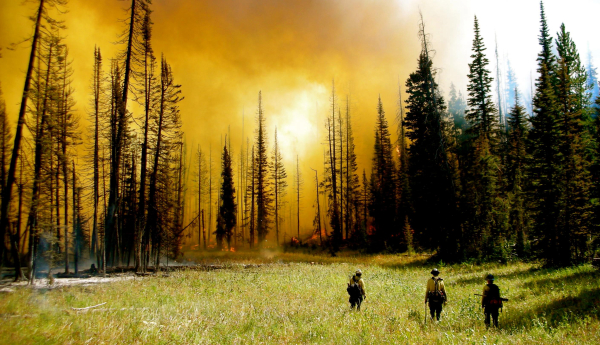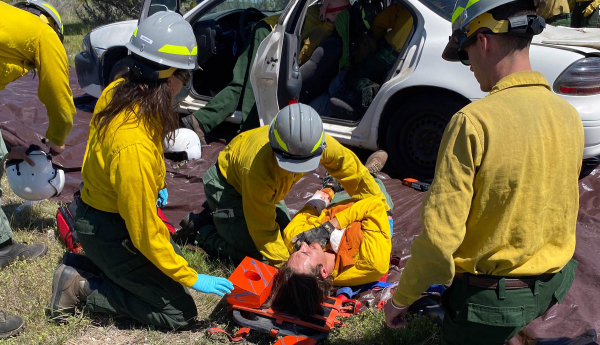The Caribou-Targhee National Forest extends like a long finger down the Idaho-Wyoming state line with seven ranger districts scattered from the storied lawless zone the U.S. Constitution forgot near Yellowstone National Park, through the range of Liger Town, all the way down to the multistate lake with its own version of the Loch Ness Monster. More than 30 map-dot-sized communities lie within 50 miles between the state line and Interstate 15. At times the forest boundary hops across the border into remote areas of Wyoming made popular by the extensive opportunities for motorized recreation.
It has been about eight years since a fire on the Caribou-Targhee National Forest was big enough to call in an incident management team. Still, forest employees – like many others across the country – spend part of the spring every year practicing different live scenarios and how their team will respond to new incidents as part of the fire season readiness review.

This year, all signs point to a very active fire year. The U.S. Department of Agriculture’s Forest Service Chief Randy Moore acknowledged in his 2024 Letter of Intent for wildland fires that the most effective strategies are collaboratively carried out at the local level. So, to be ready for the season, two of the major training scenarios coordinated for the Caribou-Targhee National Forest included working with many of the forest’s cooperating agencies to identify barriers that may unintentionally stand in the way of effective wildfire response.
North End Downed Helicopter
Bradley Bugger, Caribou-Targhee National Forest training specialist, and Briana Bolton, assistant supervisor for the Swan Valley Helitack, worked meticulously to plan the details of the training mission on the north end of the forest. It was designed with the intent to allow interagency dispatch, search and rescue, and emergency medical service professionals from the forest’s two Helitack crews, Air Idaho Rescue Partners, and Bonneville County Search and Rescue to get hands-on practice rescuing victims of a simulated helicopter crash.
Bolton was part of the air support team that responded to the Chinook helicopter crash in the Salmon River west of North Fork, Idaho, while supporting operations on the Moose Fire on the Salmon-Challis National Forest in the summer of 2022.

“We get several aircraft accidents throughout the nation every year and we don’t always know what we’re going to run into,” Bolton said. “It is critical to have folks with the training and qualifications to do this.”
Forest Service dispatch centers are expected to practice their mishap response plan every year, which includes calling up all kinds of equipment resources and moving emergency services people into action. While the forest’s two Helitack crews have only a handful of emergency medical technicians, the Caribou-Targhee has about 25 first responders across the forest. Planning training scenarios is essential to maintain first responder certifications and readiness.
“We went into it hoping to identify issues and to fix those in a training environment versus in real life,” Bugger said. “Making sure communication from Bonneville Dispatch to the East Idaho Dispatch Center was clean and thorough, making sure we were using common language, and knowing which questions we need to ask.”
A live training experience like this allows dispatch to get a real-life expectation of how to make appropriate notifications to coordinating agencies and get real-world feedback on which barriers exist to getting a timely response. In this case, a response means getting a helicopter with emergency services personnel on the scene to transport injured people to an appropriate medical facility as quickly as possible.
“In most situations, Bonneville County will be the first to respond,” Bolton said. “We do have a search and rescue plan for our forest so there is a likelihood that they could ask for our law enforcement officers, especially if the adjoining county’s air resources are unavailable.”
Bolton said they were able to figure out that the two different agencies’ helicopters were using different radio frequencies to communicate with their dispatch. They learned the Bonneville County crews were also basic-level first responders, the same as the forest emergency medical technicians. They learned that for situations requiring more advanced medical services, they may need to order ground and air ambulances sooner. Details that could mean life or death for a patient.

“Once it got going, everyone was working well together, communicating and delegating. Everybody was getting their hands dirty, and it was good,” Bolton said. “It was about the time when Bonneville County was transferring patients to the forest, and I thought, ‘Ok, this is working. We’re already learning things.’”
Bugger said next year they will loosen up the structure to allow the scenario to form a little more organically.
South End Fire Response
On the south end of the forest, representatives from each Caribou-Targhee National Forest fire zone worked with fire teams from the Bureau of Land Management, Inkom Fire, McCammon Fire, Madison County Fire and the Fort Hall Bureau of Indian Affairs to practice fire response from receiving the call from dispatch all the way through handing over the scene to an incident management team.
“Every time we get together with our cooperators it’s good because we do things our way, they do things their way, and sometimes there are assumptions made about what capabilities are there,” said Jared Fisher, Caribou-Targhee National Forest public affairs specialist. “Being able to build that cohesion and working together is important because we do end up working with those resources quite a bit when we have those urban interface fires.”
The Charlotte Fire in 2012 happened in the vicinity of where the teams conducted this scenario. With thousands of people living in a landscape covered in highly volatile juniper trees and sage brush, the fire claimed more than five dozen homes but no lives. The Idaho State Journal reported that the Idaho Bureau of Homeland Security credited the ability of these collaborating agencies to respond quickly had the fire under control in four hours and saved more than 2,000 homes in the area.
How you can be prepared
While wildland fires are becoming more extreme, wildland firefighters work to protect lives, property and natural resources when responding to wildfires. On average, 87% of all wildfires in the United States are caused by humans each year.
You can do your part. Prepare to be safe when recreating on federal lands by checking for local fire restrictions and any active fire closures before you leave. You can find them by visiting the local National Forest or Grassland web page before your in-person visit.
You can also learn about wildfire preparedness and the risk level to your community at WildfireRisk.org.
— Crystal Young, Intermountain Region, U.S. Forest Service